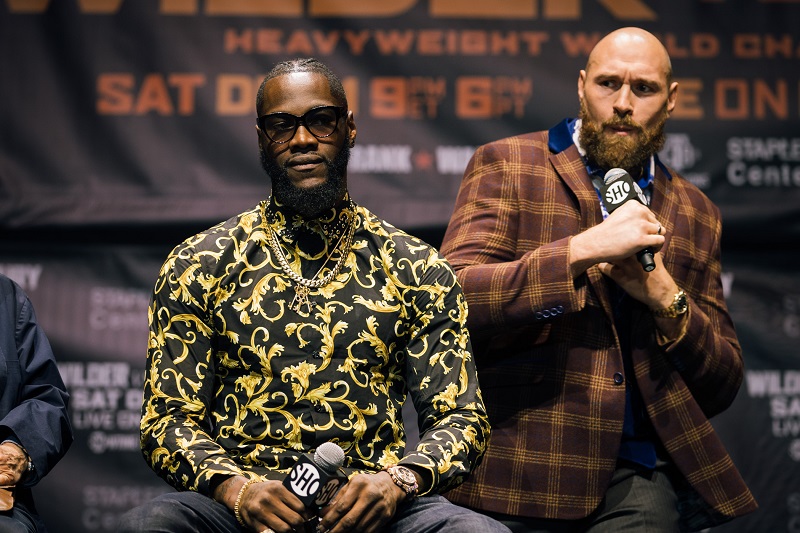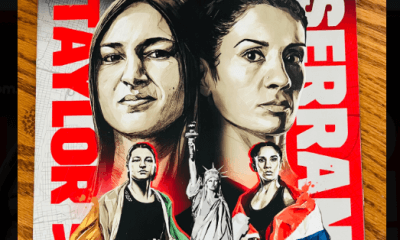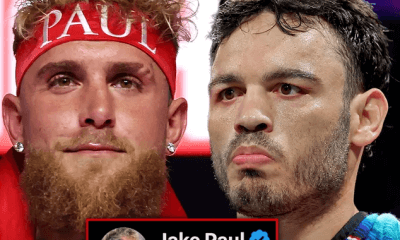Featured Articles
Deontay Wilder vs Tyson Fury: Train Crash in Los Angeles

Even though both the American World Champion Deontay Wilder and the British challenger Tyson Fury possess anatomies that could be compared to enormous mastodons, their fighting styles are complete opposites, which creates the opportunity for this bout on Dec. 1st at the Staples Center in Los Angeles to be one of the best fights of the year.
Thanks to his incredible power, which has been endured until the finish line by only one man in all of his 40 victories, “The Bronze Bomber” Wilder is the favorite to defeat “The Gypsy King” Fury (27-0-0, 19 KO’s) by knockout, thus retaining the WBC World Heavyweight Title, which he has held since 2015 and successfully defended seven times.
What Could Happen
As we previously stated, Wilder and Fury possess drastically different boxing styles, leaving the stage open for this fight to become an absolute war. However, it wouldn’t be surprising either if both were to be excessively cautious in order to avoid getting knocked out, a situation that would leave the crowd displeased, similar to what happened in the Fury vs Klitschko fight in November of 2015.
“The Gypsy King” was declared winner by unanimous decision in a fight of few punches, immeasurable clinching, and lack of technique, which led the referee to give warnings to both of them. Fury even had a point taken away in the 11th round due to landing an illegal “Rabbit Punch”. In that fight, Klitschko only landed 52 punches for an extremely low average of 4.3 punches per round, one of the lowest in title fight history. Fury was slightly better, landing 86 strikes with an average of 7.3 per round.
Wilder Did Not Look Good in the Open Media Workout
Like the popular saying “a picture is worth a thousand words”, Wilder should be worried, because regardless of his optimism, the performance he displayed in front of the California media left many unconvinced.
“I feel like I’m at my very best right now. Mentally, physically and emotionally I’m ready to go. Everything is perfect. I just want to get in the ring and show action. Tyson Fury doesn’t know what he’s gotten himself into”, said Wilder, after concluding a session on the mitts with his trainer Jay Deas at the Churchill Boxing Club in Santa Monica.
In reality, Wilder was inaccurate with his powerful right hand when he tried to strike the mitts and similarly, his movements and footwork lacked coordination. In a general sense, he lacked rhythm, regardless of his previous eloquence.
“As a true champion, I know how to adjust to any fighter that’s in front of me. My experience facing fighters of all styles has prepared me for this special fight”, stated Wilder, still covered in sweat from his training.
Born in Tuscaloosa, Alabama, Wilder will be defending his WBC World Heavyweight Title for the 8th time, which he acquired after unanimously defeating the Haitian-Canadian Bermane “B-Ware” Stiverne in January of 2015 in Stiverne’s first title defense.
In his most recent bout, Wilder defeated the Cuban southpaw Luis “King Kong” Ortíz, by TKO in the 10th round on March 3rd of this year at the Barclays Center in Brooklyn, New York. But even though he knocked down Ortíz in the 5th and a few times in the 10th, the North American was on the edge of defeat in the 7th, when the Cuban rocked him during the final seconds of the round. The champion was saved by the bell, and in the next round, Ortíz lacked the killer instinct that could have made him the first Cuban Heavyweight champion in the history of boxing. “King Kong’s” lack of aggression allowed Wilder to recover and take control of the fight. After the Cuban had been knocked down a few times, referee David Fields called a stop to the contest with 55 seconds remaining in the 10th round.
Wilder has stated that he has had excellent sparring sessions and is constantly making technical adjustments with Deas in order to be in optimal condition when he faces Fury, a fighter who lacks technique and constantly clinches, creating boring fights. This is how things transpired against the Ukrainian Klitschko exactly three years ago, when Fury won the IBF, WBA, WBO and fringe IBO title in a bout that took place in the German city of Dusseldorf.
In the weeks leading up to the fight, Jay Deas hasn’t missed an opportunity to praise the “Gypsy King”, born in the city of Manchester, a 30-year-old mastodon with an extraordinary reach of 85 inches. “Tyson Fury is kind of like a Rubik’s cube. But a Rubik’s cube can be solved. Fury is a very versatile fighter who can move, he can box and fight from lots of distances. He’s the total package as a fighter and on top of that he’s strong-willed mentally,” stated Deas.
Wilder conquered Stiverne for the title on January 12th of 2015 and during the following months and years both of them proceeded to compete several times, awaiting a second confrontation, a rematch which finally took place November 4th of 2017, in New York. Wilder quickly demolished the Haitian, knocking him down 3 times in the first round.
Fury Comes Back With Two Victories
After a long 30 months away from the sport, Fury came back, meanwhile losing more than 100lbs and recovering from drug addiction and alcoholism. Fury also confessed that he suffered from depression. One of the three titles that he acquired through defeating Klistchsko was stripped from him for having accepted a rematch with the Ukrainian, instead of his mandatory. The other two titles were immediately stripped when he tested positive for cocaine, leading to the cancelation of the rematch with Klitschko.
Fury returned victorious when he defeated the Macedonian Sefer Seferi by RTD in the 4th round on June 9th of this year at the Manchester Arena in England. Regardless of accomplishing the main objective, Fury looked very bad against Seferi due to such a long period of inactivity.
Two months later, on July 18th in Belfast, Northern Ireland, the “Gypsy King” outpointed the Italian Francesco Pianetta in a 10 round match.
Fury looked better than he did against Seferi, but still punched erratically and with minimal movement, although he did use the jab more effectively. At the end of the fight, Fury invigorated the more than 25 thousand fans present at Windsor Park, by announcing that he had accepted the offer to fight Wilder for the WBC Heavyweight World Title.
“They called, I answered. I said send me the contract. I said ‘yes’. Now he gets his chance to fight the lineal heavyweight champion of the world. Believe me, I will go to Las Vegas and I will bring home the belt. I will knock this man out.” Said Fury, causing the crowd to roar in excitement.
Who Will Win Wilder or Fury?
My opinion is that if both giants decide to make it a slugfest from the very beginning, Wilder, 6’7” in height, will be the winner within no more than 2 thirds of the fight. His devastating right hand, lethal and effective, and his superior physical condition will be enough to put Fury to sleep, a fighter who was away from the ring for two years and seven months following the fight with Klitschko. Fury’s only true advantage will be his weight, carrying approximately 40 pounds more than his opponent on the day of the fight.
Add the fact that the “Gypsy King” Fury, 6’9” in height, is a clumsy fighter with predictable movements, who lacks defense, and he will be forced to go all out in the opening rounds, using the clinch as his main weapon, in order to avoid falling victim to one of the powerful punches of the Tuscaloosa-born fighter with dynamite in his right hand.
Only tactical errors on Wilder’s side (lowering his hands, not using the jab to maintain distance and avoiding falling into the clinch) will lead to Fury’s victory. In conclusion, the American will emerge victorious by knockout before the beginning of the 8th round.
Translated by E.G. for J.J. Alvarez of Boxeo.tv
Photo credit: Amanda Westcott / SHOWTIME
Check out more boxing news on video at The Boxing Channel
To comment on this article at The Fight Forum, CLICK HERE
-

 Featured Articles4 weeks ago
Featured Articles4 weeks agoAvila Perspective, Chap. 330: Matchroom in New York plus the Latest on Canelo-Crawford
-

 Featured Articles3 weeks ago
Featured Articles3 weeks agoVito Mielnicki Jr Whitewashes Kamil Gardzielik Before the Home Folks in Newark
-

 Featured Articles21 hours ago
Featured Articles21 hours agoResults and Recaps from New York Where Taylor Edged Serrano Once Again
-

 Featured Articles4 weeks ago
Featured Articles4 weeks agoCatching Up with Clay Moyle Who Talks About His Massive Collection of Boxing Books
-

 Featured Articles5 days ago
Featured Articles5 days agoFrom a Sympathetic Figure to a Pariah: The Travails of Julio Cesar Chavez Jr
-

 Featured Articles3 weeks ago
Featured Articles3 weeks agoMore Medals for Hawaii’s Patricio Family at the USA Boxing Summer Festival
-

 Featured Articles1 week ago
Featured Articles1 week agoCatterall vs Eubank Ends Prematurely; Catterall Wins a Technical Decision
-

 Featured Articles4 weeks ago
Featured Articles4 weeks agoRichardson Hitchins Batters and Stops George Kambosos at Madison Square Garden




















